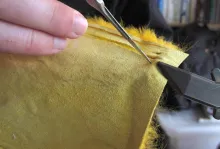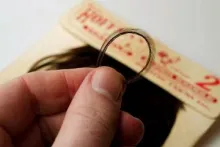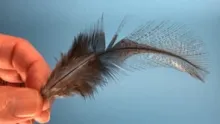In nature the marabou is a stork. In fly tying it's a very versatile and popular type of feathers from other birds than the marabou.
Even though the marabou is a large African stork and the marabou feathers indeed used to come from this bird, the marabou feathers of today come almost exclusively from turkeys and chickens.
The marabou stork (Leptoptilos crumeniferus) is actually on the CITES list of protected animals, and feathers from this bird should not be traded or used for fly-tying or anything else.
What we're dealing with in fly-tying is mainly turkey feathers. Chicken feathers can be found, but are not nearly as often labeled marabou.
The main characteristic of the marabou feather is it's fluffiness. The feather is very soft and mobile and has no willingness to"marry" and form a uniform surface like it's known from many other feathers such as body feathers, coverts and wing feathers. It's not spiky or stiff either like hackle, but is a very fluffy, downy and soft feather.
We usually divide marabou into different categories based on shape, size and use.
Blood marabou or blood quill is a short and paintbrush like feather. It's very good for wings and tails but not suited for hackles. You tie in the whole feather and utilize the fact that the barbs end in a parallel bunch in the top of the feather, giving a nice and even edge to the wing or tail. You rarely us the stem, which is often thick.
Marabou plumes are longer feathers with "normal" barbs sticking out perpendicular to the stem. These are not as long as the stem marabou, but longer than the blood feathers. They are mostly used for loose barbs, where you do not use the stem, which can be quite thick. You tie in the loose barbs in bunches or in a loop to form hackle, or use the barbs as dubbing. These are by far the most common marabou feathers.
Stem marabou AKA Woolly Bugger marabou is the longest type of feather, which is well suited for hackling in the traditional manner, where the stem is wrapped around the hook shank. You want these feathers with a long and thin stem and even and uniform barbs of the length you need. Some of these feathers are much too large and coarse to be used on smaller flies, but can be perfect for Intruder style flies and larger saltwater flies while the medium and smaller feathers can be good for bass bugs, Woolly Buggers and many other wet flies.
Bagged marabou
The far majority of marabou feathers are sold in bags, and a bag will typically consist of some 20-50 or maybe 100 feathers of varying shape, size and quality. A few manufacturers offer bags with fewer hand sorted feathers, where the feathers in a bag are all of the same type, shape and size. Unless you can clearly see that you have such a hand sorted bag in your hands, you will want to get the bag open and get the feathers out.
This will sometimes reveal a nice selection of uniform feathers, but mostly show the opposite: an amazing array of different feathers from the perfect to pure scraps, only useful for dubbing or maybe cutting off the barbs to tie in in bunches.
The bagged feathers might still be good, but just in need of some sorting, but if the selection is too inconsistent, simply leave it. The problem is that a bag with 50 feathers might contain only a few that are exactly suitable for your needs. You can also opt to buy several such bags and sort the feathers into categories. Marabou is cheap, and if the quality is good, it makes sense to buy a bunch of bags and sort them.
Strung feathers
You will often find marabou feathers in large paintbrush like bunches called strung marabou. The principle is that the feathers are sewn together at the base and rolled up to form fat bunches. You unroll the bunch and pick the feather you need. The shops will often have done this for you and cut the strips into smaller pieces, which are bagged. A whole roll is large and can contain hundreds if not thousands of feathers.
Strung marabou is often less expensive than the sorted and bagged feathers, and can be a good way of getting a hold of a lot of feathers. But the quality can also be quite inconsistent, and you will want to unpack and unroll the bunch to see what you get. Some strung feathers offer really excellent quality, and especially strung blood feathers of good quality are worth buying. On the other hand: If the price is good, you can buy almost anything with confidence, because mostly you will get a lot of useful marabou for your money.
Chickabou
Chickabou is - as the name implies - from chickens. These feathers were introduced by Whiting Farms many years ago as whole skins, but are also available as loose, bagged feathers.
They come from the lower, rear part of juvenile chickens and are much smaller than the average turkey marabou, but on the other hand very consistent in shape and also available in different barred or grizzly patterns as well as uniform colors, which is almost never the case with turkey feathers.
The size and shape make them perfect for tailing wet flies, baitfish imitations and Woolly Bugger types of flies even in smaller sizes. Buy the whole skins if at all possible. It will not only have a ton of the marabou feathers, but also contain a lot of excellent soft hackle. If you buy in bags, you definitely need to get the feathers out and check them, because even though a bag might seem stuffed with good feathers, the number of even and well formed feathers can be surprisingly low once you look closer.
Ostrich marabou
The last few years a new type of marabou have been found in many flyshops: ostrich marabou. The feathers are mainly used for soft hackles on salmon flies, and come in a large selection of colors. They are much smaller than the ostrich plumes usually sold for salmon flies, and they are mainly used for hackling, so thin stems and some length is essential.
Look for regular and even feathers with long and thin stems and dense and even barbules of the length you desire. The feathers are often of a good quality with even and consistent dye jobs, but also quite pricey, at least compared to turkey marabou. They are often sold loose, one at a time or in bags of a dozen or 20 sorted feathers.
- Log in to post comments





















